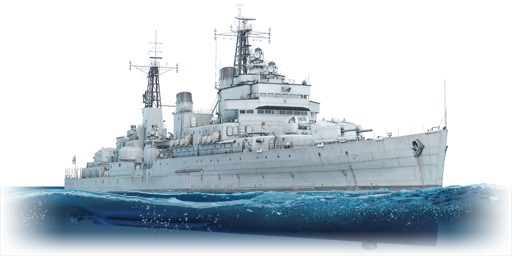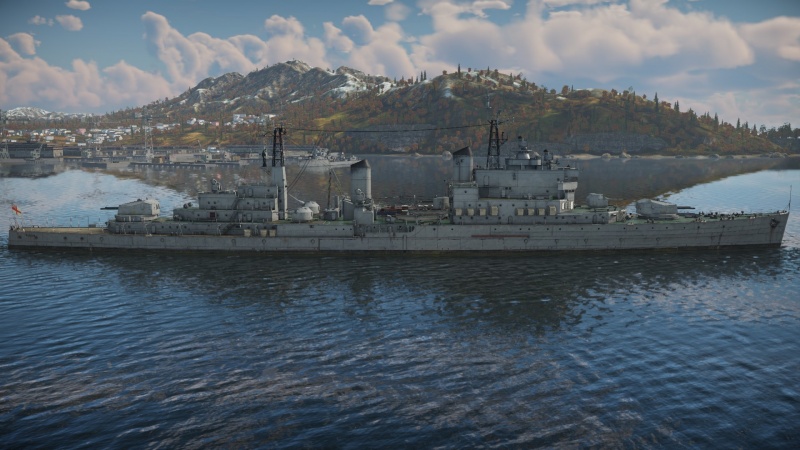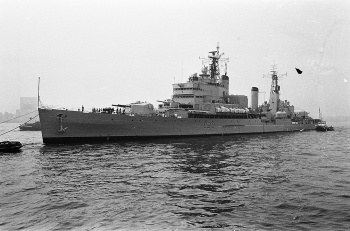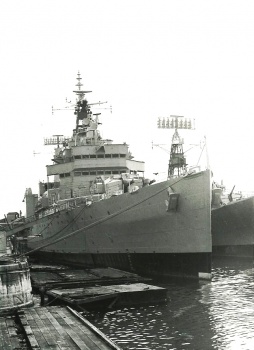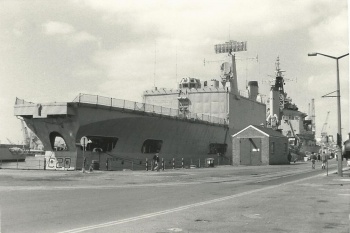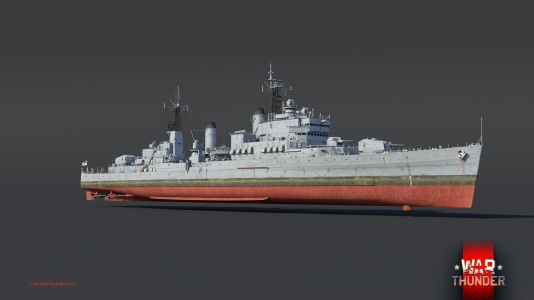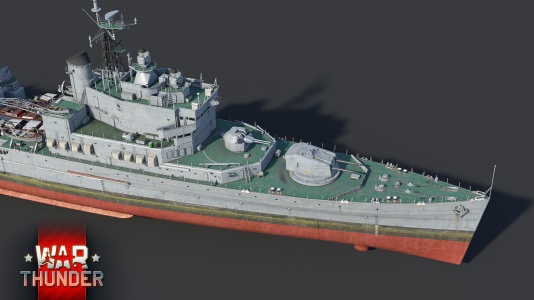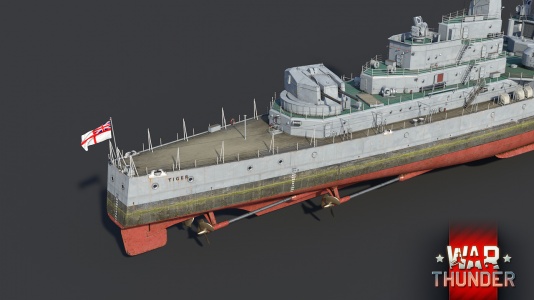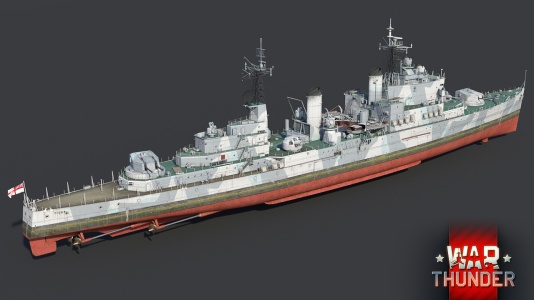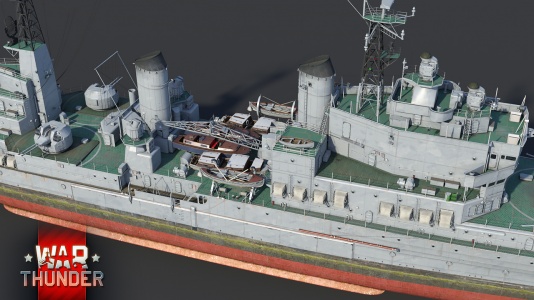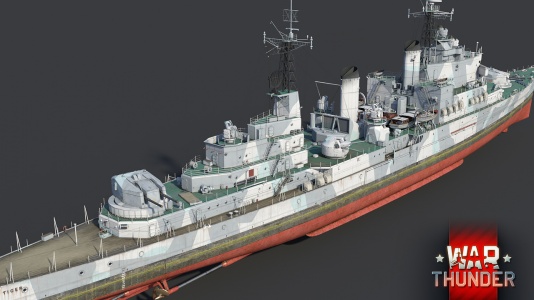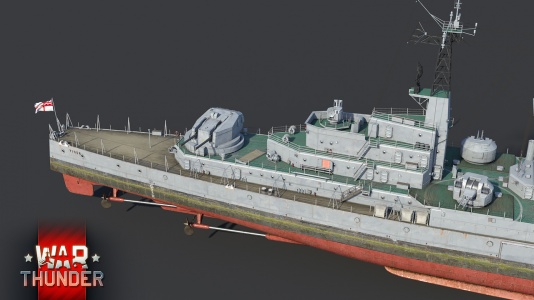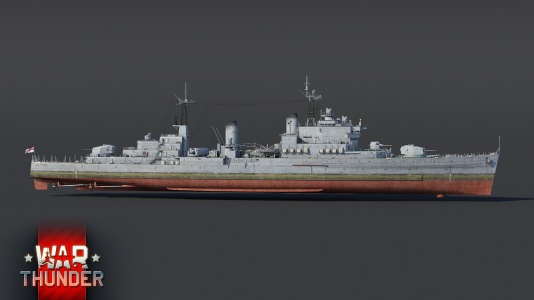HMS Tiger
Contents
Description
HMS Tiger (C20) was a member of the Tiger-class light cruisers. She was ordered for the British Navy during World War II and completed after the war. HMS Tiger entered service in 1960, serving in the Far East and then with the Home Fleet before retiring at the end of 1966. Before returning to service in the early 1970s, she was converted to a "helicopter and command cruiser" and outfitted with guided missile anti-aircraft defence. She served until 1978, when she was placed on reserve and designated for disposal. There were plans to bring her back into service for her flight deck capacity during the Falkland War, but they never materialised. HMS Tiger was eventually sold for scrap in 1986.
Introduced in Update 1.87 "Locked On" as a reward for the "Battlefield Engineer" event, HMS Tiger is an unusual cruiser. She has limited firepower and thus lacks the strike punch of contemporary light cruisers. This is partially offset by her extremely fast rate of fire. Her access to radar fire control makes her a very dangerous threat to enemy vessels, as she can compute firing solutions much faster than traditional optical rangefinders and can operate in the presence of smoke. Her quick rate of fire also allows her to adjust her fire much faster in response to enemy vessel movements, making it more difficult to consistently evade her shells. HMS Tiger is also very good at anti-aircraft defence, with access to both aircraft-tracking radar and proximity-fused shells for both primary and secondary armaments. On the other hand, she is less well protected than other modern British light cruisers, with a thinner main belt, poorer turret protection, and an exposed ammunition magazine. Players should avoid using her to engage heavier-armed vessels because they can easily penetrate the armour and detonate the ammunition magazines.
General info
Survivability and armour
The Tiger's main belt consists of a 89 mm RHA over the magazines, thinning out to 82.55 mm over the machinery space. There is also the second section of 51 mm RHA that extends above the main belt to provide additional protection to the engine compartment. The citadel ends are protected by only 51 mm of RHA.
The main gun turrets are lightly armoured, with 55 mm RHA on the front turret face and 20 mm on the rest of the turret. The deck armour plating consists of 50 mm RHA that covers the entire length of the ship. Unlike the majority of its tech tree equivalents, this armour is situated on the weather deck, effectively protecting not just the engines rooms but all systems below the bridge and turrets. This provides effective protection against plunging fire from light cruiser AP shells and smaller.
The main battery magazines are located below the waterline and protected by the main belt. However, the main gun shells rooms are only protected by the 25 mm barbette armour, and are thus quite vulnerable. Destroying these will not instantly destroy the ship, but will still cause heavy damage and eliminate all ammunition for the associated turret, rendering it unable to fire. The secondary gun magazines are situated entirely behind the main armour belt.
The bridge and radio room are completely unprotected. This makes them extremely vulnerable to getting disabled from even small calibre hits.
The Tiger has a reasonably sized crew count of 880, which is above average for a British cruiser although smaller than that of the Belfast.
Mobility
The Tiger has a slower top speed than the other contemporary British light cruisers, with mobility comparable to that of the Arethusa. She is considerably larger than the Arethusa, and thus is a bit less manoeuvrable.
| Mobility Characteristics | |||
|---|---|---|---|
| Game Mode | Upgrade Status | Maximum Speed (km/h) | |
| Forward | Reverse | ||
| AB | |||
| Upgraded | 68 | 40 | |
| RB/SB | |||
| Upgraded | 58 | 34 | |
Modifications and economy
Armament
Primary armament
The main armament consists of four 6 inch/50 QF Mark N5 guns mounted in two turrets, one forward and one aft. These guns are able to fire HE, AP, and HE-VT. These guns have a maximum rate of fire of 20 rounds/minute with the best possible crew, by far the quickest reload of a gun this calibre. Her quick reload allows her to rapidly switch ammunition types to best suit the current situation. Despite the fast reload, because she only has four guns the Tiger's maximum shell output (4 x 20 = 80 rounds/minute) is still significantly lower than that of the other contemporary British light cruisers, Belfast and Southampton (12 x 8 = 96 rounds/minute).
The Tiger is the only British light cruiser with proper AP shells. These have significantly more penetration than the CPBC SAP shells normally found on British light cruisers at the cost of having only half the explosive filler. Her HE shells are significantly more powerful than the standard British 6 in HE shell, having nearly twice the explosive filler.
The main gun turrets are true dual purpose mounts, featuring a fast turret traverse (17°/second), high gun elevation (80°), and wide firing arcs of ±150°. Both turrets can also traverse through 360°, allowing the Tiger to keep track of targets (especially air targets) no matter their position relative to the ship. The HE-VT shell is also highly effective against aircraft.
As a postwar ship, the Tiger is also one of the few British ships equipped with radar fire-control, allowing her to obtain firing solutions at much higher speeds than traditional optical rangefinders, and to maintain target tracking through smoke. She can also use the radar to obtain firing solutions against aircraft, greatly enhancing the usefulness of both her main and secondary guns against aircraft.
| Penetration statistics | |||||||
|---|---|---|---|---|---|---|---|
| Ammunition | Type of warhead |
Penetration @ 0° Angle of Attack (mm) | |||||
| 1,000 m | 2,500 m | 5,000 m | 7,500 m | 10,000 m | 15,000 m | ||
| 6 inch HE | HE | 59 | 59 | 59 | 59 | 59 | 59 |
| 6 inch AP | APCBC | 273 | 243 | 200 | 167 | 141 | 112 |
| 6 inch HE-VT | HE-VT | 59 | 59 | 59 | 59 | 59 | 59 |
| Shell details | ||||||||||||
|---|---|---|---|---|---|---|---|---|---|---|---|---|
| Ammunition | Type of warhead |
Velocity (m/s) |
Projectile mass (kg) |
Fuse delay (s) |
Fuse sensitivity (mm) |
Explosive mass (TNT equivalent) (g) |
Ricochet | |||||
| 0% | 50% | 100% | ||||||||||
| 6 inch HE | HE | 768 | 59.9 | 0 | 0.1 | 7,810 | 79° | 80° | 81° | |||
| 6 inch AP | APCBC | 768 | 58.9 | 0.025 | 7 | 884 | 48° | 63° | 71° | |||
| Proximity-fused shell details | ||||||||||||
|---|---|---|---|---|---|---|---|---|---|---|---|---|
| Ammunition | Type of warhead |
Velocity (m/s) |
Projectile mass (kg) |
Fuse delay (m) |
Fuse sensitivity (mm) |
Arming distance (m) |
Trigger radius (m) |
Explosive mass (TNT equivalent) (g) |
Ricochet | |||
| 0% | 50% | 100% | ||||||||||
| 6 inch HE-VT | HE-VT | 768 | 59.9 | 0 | 0.1 | 244 | 23 | 7,810 | 79° | 80° | 81° | |
Secondary armament
The secondary armament consists of a six the 3 inch/70 Mark 6 dual-purpose guns in three twin turrets, one ahead of the bridge and one on either side of the superstructure. These guns have very high rate of fire of 90 rounds/minute until the 322 ready-use rounds for each turret are depleted, whereupon it will drop to a still-respectable 75 rounds/minute. All turrets can rotate through 360° and can elevate up to 89°, although for obvious reasons they cannot fire through the superstructure of the ship. They are highly accurate even out to the maximum range of around 9.8 km
These turrets only fire one type of ammunition, the NC101 HE-VT proximity fused shell. This shell is highly effective against aircraft and coastal boats, and can even be used to knock out the open main gun mounts of some destroyers.
The Tiger's secondary guns also benefit from the use of the radar fire control, allowing them to potentially be used to engage aircraft at long range.
| Penetration statistics | |||||||
|---|---|---|---|---|---|---|---|
| Ammunition | Type of warhead |
Penetration @ 0° Angle of Attack (mm) | |||||
| 100 m | 1,000 m | 2,000 m | 3,000 m | 4,000 m | 5,000 m | ||
| NC101 HE-VT | HE-VT | 9 | 9 | 9 | 9 | 9 | 9 |
| Proximity-fused shell details | ||||||||||||
|---|---|---|---|---|---|---|---|---|---|---|---|---|
| Ammunition | Type of warhead |
Velocity (m/s) |
Projectile mass (kg) |
Fuse delay (m) |
Fuse sensitivity (mm) |
Arming distance (m) |
Trigger radius (m) |
Explosive mass (TNT equivalent) (g) |
Ricochet | |||
| 0% | 50% | 100% | ||||||||||
| NC101 HE-VT | HE-VT | 1,036 | 6.8 | 0 | 0.1 | 270 | 10 | 528 | 79° | 80° | 81° | |
Usage in battles
The Tiger is a rather unusual cruiser. She has only four guns in two turrets, thus she lacks the first strike punch of most contemporary light cruisers (which have anywhere between 9 to 12 guns). Losing one turret will also effectively cut her firepower in half. However, this is somewhat compensated for by her very high rate of fire, thus if the situation permits she can still rack up a considerable amount of damage over time, helped by the large explosive filler of her HE shells. She also has access to AP, and is thus able to penetrate the main belts of other cruisers at ranges where the CPBC SAP shell of other British 6 in gun cruisers will struggle. Her access to radar fire control makes her a very dangerous threat to destroyers because it can compute firing solutions at a much faster rate than traditional optical rangefinders and can continue functioning through smoke. Her fast rate of fire also allows her to adjust her fire much more quickly in reaction to destroyer movements, making it harder to consistently evade her shells.
It is in the anti-aircraft role that the Tiger excels in particular, with all her armament consisting of dual-purpose guns capable of firing HE-VT. Her radar fire control system also works against aircraft, allowing her to compute firing solutions against aircraft and further enhancing the effectiveness of her dual--purpose guns.
The Tiger is, however, less well-protected than the other contemporary British light cruisers, especially Belfast, having a thinner main belt, worse turret protection, and exposed shell rooms. She tends to fare poorly in slugging matches, as it is relatively easy to disable her main gun turrets (often permanently by detonating the shell rooms, removing their ammunition). She also has no torpedoes, and thus has no real answer to battleships.
Pros and cons
Pros:
- Very high rate of fire on both main and secondary guns
- All guns can traverse 360° and elevate enough to fire on aircraft and have access to HE-VT shells
- Access to high-penetration main gun AP shells
- Above average explosive filler for HE/HE-VT shells
- Above average crew count for a British cruiser
- Radar fire control
Cons:
- Below average broadside shell count (four shells) with mediocre accuracy
- Has only two lightly armoured main gun turrets
- Shell room is above the main armoured belt
- Relatively low top speed
- Unarmoured bridge
- Can be matched against battleships
History
HMS Tiger (C20) was the lead ship of the Tiger-class, a set of three light cruisers built for the Royal Navy following the end of the Second World War. Initially laid down as a Minotaur-class light cruiser (a smaller derivative of the Crown Colony and Town class cruisers), she was completely redesigned while being built and eventually launched as a completely new design. Featuring an advanced semi-automatic main battery and fully-automatic anti-aircraft armament, she was the last "gun cruiser" built for the Royal Navy.
HMS Tiger was launched in 1945, but inefficiencies in her construction resulted in her being completed almost 15 years later in 1959. She served as the flagship of the Mediterranean fleet from 1959 to 1960, and later participated in the Indonesian confrontation. In 1968, she began a lengthy conversion into a command helicopter cruiser. This resulted in the removal of her aft guns and the installation of a massive hangar and deck complex, from which she could operate multiple Westland Wessex antisubmarine helicopters. HMS Tiger was subsequently used as a flagship. Due to her high crew complement and high operating costs, HMS Tiger was decommissioned in the late 1970s and placed in reserve, ultimately being scrapped in the late 1980s.
Design and development
During the Second World War, the British navy conducted a massive cruiser-building program, building many vessels of the Dido, Arethusa, Town, Crown Colony and Minotaur (Swiftsure) classes. The last of these classes, the Minotaur / Swiftsure class, was under construction in 1944 when the British navy realized that there was neither the budget, nor the manpower, to operate those ships. As a result, the British naval command decided to barter with the Royal Australian Navy (RAN) to get them to purchase two Minotaur-class cruisers for the cost of 9 million British pounds. However, this deal failed to materialize, and as a result, the last three ships of the Minotaur-class were suspended. They sat in drydock, possibly waiting to be disposed of. However, a dramatic change in British naval construction plans saved them from the breaker's yard.
Cruiser vs destroyer debate
In 1945, it was hoped that the Battle-class destroyers could accomplish most of the roles that cruisers could, thereby eliminating the need for cruisers. However, British First Sea Lord Andrew Cunningham realized that there wasn't enough budget for the construction of new, 3-turreted destroyers (later the Daring-class) that could truly accomplish the roles of cruisers. As a result, the Royal Navy decided that they would need to build a new class of cruisers. The only hulls available for this purpose were the three unfinished Minotaur-class hulls: Bellerophon (renamed Tiger), Defence (renamed Lio'), and Blake (retained her name). As a result, the Tiger was launched, albeit in an unfinished state, in late 1945.
Meanwhile, the argument about cruisers persisted. Several designs were considered and argued, while the choice of main armament (mainly the choice between 5-inch, 5.25-inch or 6-inch guns) was contested as well. By 1948, a new Minotaur-class design had been developed (otherwise known as Design Z), mounting ten 6-inch guns in five automatic dual turrets and displacing almost 18000 tons fully loaded. However, with the reelection of Winston Churchill in 1951, the British naval budget was reduced, and the Design Z 'Minotaurs' were cancelled. Between 1945 and 1954, no work was done on the Tiger-class cruisers. However, in 1954, it was decided that the Tigers would be completed, albeit to a completely new design, using completely new armament.
Hull, sensors and armament
The redesigned Tiger-class was designed with a main battery of four 6-inch QF Mk N5 guns in two double semi-automatic dual-purpose (DP) guns. These weapons had initially been developed as a faster-firing version of the BL Mk 23 guns mounted on the preceding cruiser classes. HMS Tiger received the weapon with a brand-new semi-automatic turret, allowing rates of fire of up to 20 rounds per minute (RPM). As well, the Tiger's main armament was capable of 360-degree rotation. In practice, the Mk N5 guns were extremely unreliable and jammed after just 30 seconds of continuous fire; however, RN command found this to be irrelevant, as the response speed after enemy detection was believed to be the determining factor in future naval engagements; this was especially true for dealing with the fast-flying jet aircraft of the Tiger's time.
HMS Tiger was armed with an anti-aircraft armament of six 3-inch QF Mk N1 guns in three dual turrets. These guns had an extremely high rate of fire at 90-120 RPM, but were prone to jamming after short bursts, similar to her primary armament.
The Tiger's hull was retained from her original 1945 design, but was widened substantially to accommodate her new equipment. She also received a completely new, modernized superstructure that was much wider than the superstructures fitted to her WWII counterparts; thus, she is easily distinguished from ships such as HMS Swiftsure, her half-sister.
HMS Tiger carried a Type 992Q surface radar with a range of 56 km, a Type 960 air warning radar with a range of 310 km, a Type 277Q surface/air radar with a range of 220 km, and five MRS 3 fire directors for each 6-inch and 3-inch turret. Her peacetime crew complement would've been 698 officers and men, while her wartime crew complement would've been almost 900 crew members. The implementation of these changes took nearly four years; as a result, HMS Tiger was fully commissioned on March 18th, 1959.
Operational history
Following her launch, the HMS Tiger spent most of 1959 and 1960 in trials testing her highly-advanced armament. It was during this time that the navy realized the true extent of her armament's unreliability - her 3-inch guns experienced teething troubles that resulted in severe unreliability, while her 6-inch guns were prone to jamming after short periods of firing. The 3-inch gun issues were mostly fixed by late 1960, but her 6-inch guns remained unreliable and were never fully fixed. During this time, she sailed to visit several Baltic ports, and deployed to the Mediterranean as the flagship of the British Mediterranean fleet.
In the earlier part of the 1960s, HMS Tiger deployed to the eastern theatre to serve during the Indonesian Confrontation. However, her operational capabilities were hindered by a lack of crew members, due to the Navy manpower shortages of the '60s. She was known by the public to be "only partly operational", and the Glasgow Herald went as far as calling the Tiger a "floating office". In 1966, she hosted talks between the British government and the new Rhodesian leadership under Ian Smith, who had unilaterally declared independence from the United Kingdom.
Later career and conversion
HMS Tiger was placed in reserve in 1966, being extremely obsolete due to the introduction of new guided-missile surface combatants. However, the decision was made to convert her, along with her sister ships, into guided helicopter cruisers. At the time, the British parliament had found that this would've been the cheapest option, costing 5 million pounds per vessel. The conversion took until 1972; the Tiger's rear armament was removed, and replaced with a massive flight deck and hangar to support the operation of four Westland Wessex helicopters. The rear pair of 3-inch mounts were removed and replaced with a pair of Sea Cat missile launchers for launching Sea Cat Surface-to-air missiles.
By 1972, the Tiger was operational again, and the government wasn't happy about it; the conversion had cost 12.8 million, rather than the 5 million it was supposed to cost. As a result, the Lion's conversion was cancelled, and she was placed into reserve; Lion ended up as a spare parts ship, providing parts for the Tiger and Blake. This was done to such an extent that the Tiger's crew members began calling her the 'Liger', due to the massive amount of Lion's parts used to keep her operational.
HMS Tiger saw little service as a helicopter cruiser, being decommissioned in 1978. Her only major event during this time was the 1977 Silver Jubilee fleet review for Queen Elizabeth II. Being an extremely large vessel, she was costly to operate compared to the guided missile destroyers that the Royal Navy had invested itself into. Thus, she was placed on the "awaiting disposal" list in early 1979, along with her sister Blake.
In early 1982, the Falklands war broke out, and HMS Tiger was immediately reactivated, along Blake. The Royal navy had seriously considered sending the Tigers to the Falklands for several reasons; firstly, their large 6-inch main artillery guns could be used for shore bombardment, but more importantly, they had the third-largest helicopter decks in the Royal Navy (after the carriers Hermes and Invincible). In fact, the decks were large enough to operate the Sea Harrier S/VTOL aircraft, and this capability had been tested by Blake in the early 70s. However, at the end, the ship's large operating costs doomed them, and both were inactivated again once the Falklands conflict came to a close. HMS Tiger remained in reserve until 1986, when she was sold for scrap.
Devblog
The three Tiger-class cruisers were initially laid down as Minotaur-class cruisers early on in WW2. However, their construction priority was considered low as British naval warfare at the time centred a lot around anti-submarine warfare - a role which ships of this class weren't intended to fill. Thus, the ships would only be partially completed by the end of WW2, with their design being acknowledged as outdated.
After WW2, the decision was made to complete the ships' construction, but to a different design. Work on completing the new Tiger-class light cruiser began in the early 1950s with the ships seeing completion by the end of the decade. The ships were refitted and modernized extensively, however, they remained outdated designs due to rapid advancements in technology and the changing nature of warfare. As a result, the class was soon afterwards converted into helicopter cruisers and went on to serve with the Royal Navy until the late 1970s. Tiger-class light cruisers were the final British 6-inch gun armed cruisers and the world's last large-calibre artillery ships, no one else has built such ships.
Media
- Skins
- Images
- Videos
See also
Links to articles on the War Thunder Wiki that you think will be useful for the reader, for example:
- reference to the series of the ship;
- links to approximate analogues of other nations and research trees.
External links
References
- Academic. (2010). HMS Tiger (C20). Retrieved January 04, 2021, from https://enacademic.com/dic.nsf/enwiki/296347
- Sharma, R. (2018, January 23). HMS Tiger (C20) - Alchetron, The Free Social Encyclopedia. Retrieved January 04, 2021, from https://alchetron.com/HMS-Tiger-(C20)
| John Brown & Company | |
|---|---|
| Destroyers | |
| Daring-class | HMS Diamond |
| Light Cruisers | |
| Emerald-class | HMS Enterprise |
| Town-class | HMS Southampton |
| Tiger-class | HMS Tiger |
| Battlecruisers | |
| Admiral-class | HMS Hood |
| Britain light cruisers | |
|---|---|
| Emerald-class | HMS Enterprise |
| Dido-class | HMS Dido |
| Leander-class | HMNZS Leander |
| Arethusa-class | HMS Arethusa |
| Town-class | HMS Belfast · HMS Liverpool · HMS Southampton |
| Tiger-class | HMS Tiger |
| Abdiel-class* | HMS Abdiel |


